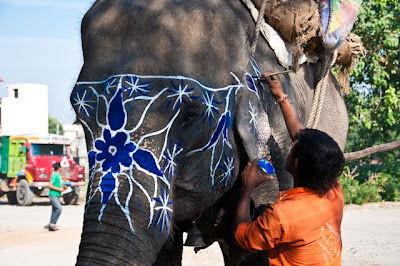Not very long ago, Delhiites went to the Yamuna riverfront at Okhla for picnic. Not very long ago, events like the National Sailing Regatta were held at Kalindi Kunj, Okhla. And, not very long ago, there was abundant fish in the Yamuna.
 |
| Imagine there was a river - open panel discussion at Okhla Barrage |
Yamuna Katha core team member Bhola Kashyap, 41, is a resident of Madanpur Khadar but spends most of the time at the Okhla ghat. Bhola is a fisherman and also a ‘life guard’ for the Okhla ghat. He belongs to a community called kewat, which are traditionally into fishing.
Not much into studies, Bhola jumped into business at a tender age. He now has the fishing trade license for the area downstream of Okhla barrage. He also has a number of boats. “Rozi roti hee Jamuna se hai. (My very livelihood comes from Yamuna).” They call the river as ‘Jamuna Maiyya’.
 |
| Chothe Khan, Bhola and Shubham Mishra |
“Our community’s link with the Yamuna is beyond words,” Babita said. They have a Yamuna idol and the lady of the house worships it daily.
The time and the location for the open forum discussion ‘Imagine there was a river’ was apt. Coming days after the Durga puja visarjan (immersion), the river bank lay scattered with an array of wooden and plaster of Paris skeletons used to support Durga puja idols. Much of them had refused to flow away with the river and came floating back to the bank making it appalling than ever.
 |
| Durga Puja idols |
 |
| ... turning from sacred idols into pollution |
On the last day of the Yamuna Katha, Rakhshanda Jalil from the Council for Social Development and Arif Ali, who teaches at the Jamia Milia Islamia joined the Yamuna Katha team here. Also present was the Yamuna Katha team: Anaya, Shubham, Bhola, Chhotu, Babita, Gayatri, Rashid, Kalia, Aparna, Arif, Rakhshanda, Regina and Vidhu. Three fishermen from the locality Bhupender Kanhaiyyalal Sahani, Aseshwar Sahani (Bihar, Muzzafarpur) and Mohammed Shakil Khan along with Bhola’s uncle Ratan Singh too joined in.
Arif initiated the discussion expressing sadness about the sorry state of the Yamuna today. “I have spent my childhood on the banks of the Yamuna. Later on when I travelled all over the world and saw how in foreign lands how they keep their rivers clean, it pains me more over the plight of Yamuna,” he rued.
 |
| Prof. Arif Ali |
Rakshanda joined in to add that she has seen the area changing drastically and for bad. “We have turned blind towards the river. We have stopped coming here and may be, that’s the reason for deteriorating conditions.”
Bhupender, Aseshwar and Shakil informed they use fish nets to catch fish and stay on the Yamuna banks itself. “But pollution has brought down the quantity of the catch. There is less and less water over the years.”
An academician that he is, Arif quickly presented the statistical reality: “Delhi has only 2 % of entire length of Yamuna, but we contribute up to 90 % of its pollution.”
Sitting on a riverfront of toxic foam today, Okhla was not always like this always. One of the oldest villages of Delhi, maximum of the residents are original Delhi walas, prominent among them being herdsmen, gwale, ghosi, kumhars etc (names of the communities drawn from their traditional occupation).
The Okhla riverfront was developed as a picnic spot way back in 1870s by the British. But up to 1950s and 1960s, there was no public transport to reach here and only people with own vehicle came. That was why the accessibility was restricted. It was an isolated, but a vibrant riverfront.
 |
| Local fisherman engaging in the discussion |
But slowly the city’s population started being a burden on the river. Pollution has almost killed the river. Bhola chipped in, rather he is confident: if the river becomes pollution free again, only then people of Delhi will flock to it. It prompted Shubham to warn: though it is important that people keep come to the river, but there has to be a debate as to what kind of a riverfront we want? Involvement of locals is equally important too.
Aparna posed a practical problem: “Bhola wants more and more clear water for fish. A person sitting at Dwarka wants the river’s clear water for drinking. Bhola and I do not speak the same language. We do not share a common past. So how can we talk of a common future? Who will work out the framework?”
Regina put the things in context as she pointed out that it is necessary to discuss all kinds of usage of the river, river water and river floodplains too. Quickly Bhola vent his ire at the pollution caused by Durga puja immersion and other such occasion. “Nobody fines them for pollution?”
 |
| Gayatri Chatterjee, Regina Dube, Rakshandra Jalil |
Aparna justified, “Visarjan can be seen. What about that which is unseen? The industrial pollution cannot be seen.”
Bhola refused to buy the argument. “Before the Visarjan, the Chhath puja etc, the entire machinery is put to work … they clean the ghats, they release more water and for a day or two, Yamuna and the banks are clean. If they can do it for three times a year, why can’t they do it for rest of the year?”
The session ended on a high note as Rakshanda supported Bhola, “While we ponder for long term things and make plans, I think Bhola’s idea is ‘doable’.”
 |
| Fisherman fishing in filthy water in front of Okhla Barrage |
And with renewed vigour ‘it is possible’, the Yamuna Katha team headed for lunch, after which was the winding up session at the hotel.











